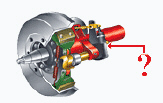True/False
Indicate whether the
statement is true or false.
|
|
|
1.
|
To test the low air pressure warning signal, shut the engine off after you have
enough air pressure so that the low air pressure warning signal shuts off. Then, turn on the
electrical power and pump the brake pedal until the air pressure drops below 60 psi and the low air
pressure warning signal comes on.
|
|
|
2.
|
The braking power of the spring brakes depends on the adjustment of the service
brakes.
|
|
|
3.
|
You should be in the proper gear before starting down a hill so that you do not
need to downshift after your speed has built up.
|
|
|
4.
|
Air brakes may fade, but they will never fail completely.
|
|
|
5.
|
“Stab braking” during an emergency means applying your brakes all
the way until wheels lock up, then releasing until the wheels start rolling, then repeating as
necessary.
|
|
|
6.
|
Vehicles with antilock braking systems (ABS) have yellow malfunction lamps to
tell the driver if something is wrong.
|
|
|
7.
|
When a low pressure warning device comes on, you have up to an hour before you
have to stop.
|
|
|
8.
|
The air compressor governor controls the air pressure applied to the
brakes.
|
|
|
9.
|
On a long, steep downgrade, use of your air brakes is the primary means of
slowing your vehicle.
|
|
|
10.
|
The item identified in this picture is the slack adjuster: 
|
Multiple Choice
Identify the
choice that best completes the statement or answers the question.
|
|
|
11.
|
A warning signal that can be seen by the driver must come on before the air
pressure in the brake tanks falls below _____ psi (pounds per square inch).
|
|
|
12.
|
Which of the following is the first thing a driver should do when a low pressure
warning signal comes on:
a. | Proceed to the closest repair facility. | b. | Continue to your
destination at a reduced speed. | c. | Stop right away and safely park the vehicle so
the problem can be fixed. | d. | Push in the air release
valve. |
|
|
|
13.
|
The most common type of foundation brake found on heavy trucks is
the:
a. | Disc brake. | b. | Wedge drum brake. | c. | S-cam drum
brake. | d. | Engine brake. |
|
|
|
14.
|
Before driving a vehicle with a dual air system, a driver must allow time for
the air compressor to build up a minimum of ________ psi air pressure in both the primary and
secondary systems.
|
|
|
15.
|
To make sure the spring brakes come on automatically on a tractor
trailer, pump the brakes to reduce the air pressure until the tractor protection valve and parking
brake valve close (pop out) when the air pressure falls to the manufacturer’s specifications,
which are between _____ and _____ psi.
a. | 10-20 | b. | 20-30 | c. | 20-40 | d. | 40-50 |
|
|
|
16.
|
When testing a combination vehicle air brake system for leaks, with the
engine off and the brakes released, the system should not leak at a rate of more than ______ psi per
minute.
|
|
|
17.
|
The air compressor governor controls:
a. | The air that flows to the air pressure gauge. | b. | The air pressure
applied to the brake drums. | c. | When air is pumped into the air storage
tanks. | d. | The release of air pressure from the brake chambers. |
|
|
|
18.
|
What does an alcohol evaporator do?
a. | Reduce alcohol in the air tanks. | b. | Add alcohol to the air
tanks. | c. | Reduce the risk of ice in the air brake system in cold weather. | d. | Eliminate the oil in
the air brake compressor. |
|
|
|
19.
|
The brake pedal applies and releases the __________ brakes.
a. | emergency | b. | service | c. | secondary | d. | test |
|
|
|
20.
|
The air loss rate for a straight truck with the engine off and the brakes
on should not be more than:
a. | 1 psi in 30 seconds. | c. | 3 psi in one minute. | b. | 1 psi in one minute. | d. | 2 psi in 45
seconds. |
|